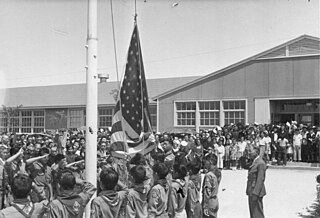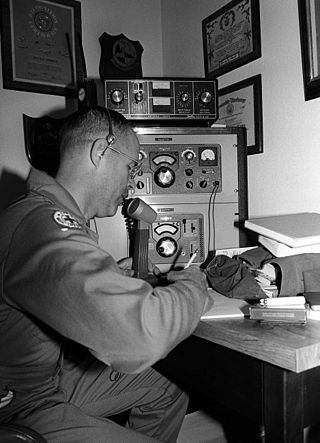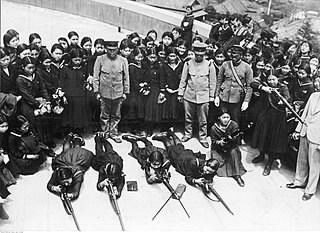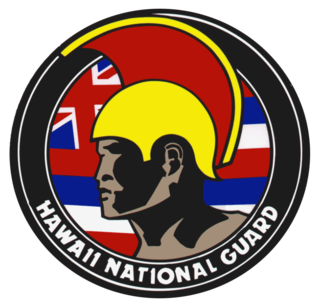
The British Army is the principal land warfare force of the United Kingdom, a part of the British Armed Forces along with the Royal Navy and the Royal Air Force. As of 2022, the British Army comprises 79,380 regular full-time personnel, 4,090 Gurkhas, and 28,330 volunteer reserve personnel.

A militia is generally an army or some other fighting organization of non-professional and/or part-time soldiers; citizens of a country, or subjects of a state, who may perform military service during a time of need, as opposed to a professional force of regular, full-time military personnel; or, historically, to members of a warrior-nobility class. When acting independently militias are generally unable to hold ground against regular forces; militias commonly support regular troops by skirmishing, holding fortifications, or conducting irregular warfare, instead of undertaking offensive campaigns by themselves. Local civilian laws often limit militias to serve only in their home region, and to serve only for a limited time; this further reduces their use in long military campaigns. Militias may also, however, serve as a pool of available manpower for regular forces to draw from, particularly in emergencies.

During the early years of World War II, Japanese Americans were forcibly relocated from their homes in the West Coast because military leaders and public opinion combined to fan unproven fears of sabotage. As the war progressed, many of the young Nisei, Japanese immigrants' children who were born with American citizenship, volunteered or were drafted to serve in the United States military. Japanese Americans served in all the branches of the United States Armed Forces, including the United States Merchant Marine. An estimated 33,000 Japanese Americans served in the U.S. military during World War II, of which 20,000 joined the Army. Approximately 800 were killed in action.

The Army Reserve is the active-duty volunteer reserve force of the British Army. It is separate from the Regular Reserve whose members are ex-Regular personnel who retain a statutory liability for service. The Army Reserve was known as the Territorial Force from 1908 to 1921, the Territorial Army (TA) from 1921 to 1967, the Territorial and Army Volunteer Reserve (TAVR) from 1967 to 1979, and again the Territorial Army (TA) from 1979 to 2014.

IV Corps was a corps-sized formation of the British Army, formed in both the First World War and the Second World War. During the First World War the corps served on the Western Front throughout its existence. During the Second World War it served in Norway and Britain until it was transferred to India, which was threatened with attack after Japan entered the war.
The Officers' Training Corps (OTC), more fully called the University Officers' Training Corps (UOTC), are military leadership training units operated by the British Army. Their focus is to develop the leadership abilities of their members whilst giving them an opportunity to take part in military life whilst at university. OTCs also organise non-military outdoor pursuits such as hill walking and mountaineering. UOTC units are not deployable units nor are their cadets classed as trained soldiers until completion of MOD 1 training. The majority of members of the UOTC do not go on to serve in the regular or reserve forces.

Auxiliaries are support personnel that assist the military or police but are organised differently from regular forces. Auxiliary may be military volunteers undertaking support functions or performing certain duties such as garrison troops, usually on a part-time basis. Unlike a military reserve force, an auxiliary force does not necessarily have the same degree of training or ranking structure as regular soldiers, and it may or may not be integrated into a fighting force. Some auxiliaries, however, are militias composed of former active duty military personnel and actually have better training and combat experience than their regular counterparts.

United States military bands include musical ensembles maintained by the United States Army, United States Marine Corps, United States Navy, United States Air Force, and United States Coast Guard. More broadly, they can also include musical ensembles of other federal and state uniformed services, including the Public Health Service and NOAA Corps, the state defense forces, and the senior military colleges.

Volunteer Fighting Corps were armed civil defense units planned in 1945 in the Empire of Japan as a last desperate measure to defend the Japanese home islands against the projected Allied invasion during Operation Downfall in the final stages of World War II.
The history of the Australian Army is the culmination of the Australian Army's predecessors and its 120-year modern history. The Army has its origins in the British Army and colonial military forces of the Australian colonies that were formed prior to the Federation of Australia. These were gradually united into federal units between 1899 and 1903; thus forming the beginning of the Australian Army. The colonial forces were combined and formed the basis of the new army, when the Commonwealth of Australia was founded on 1 January 1901. The modern history of the Army began with its founding at the start of the 20th century as the colonial armies were officially united as the Commonwealth Military Forces. In 1916 the title 'Australian Military Forces' was adopted and remained its official name until 1980, after which it became known as the Australian Army.

The militia of the United States, as defined by the U.S. Congress, has changed over time. During colonial America, all able-bodied men of a certain age range were members of the militia, depending on each colony's rule. Individual towns formed local independent militias for their own defense. The year before the US Constitution was ratified, The Federalist Papers detailed the founders' paramount vision of the militia in 1787. The new Constitution empowered Congress to "organize, arm, and discipline" this national military force, leaving significant control in the hands of each state government.

The Hawaii National Guard consists of the Hawaii Army National Guard and the Hawaii Air National Guard. The Constitution of the United States specifically charges the National Guard with dual federal and state missions. Those functions range from limited actions during non-emergency situations to full scale law enforcement under martial law when local law enforcement officials can no longer maintain civil control. The National Guard may be called into federal service in response to a call by the President or Congress. When National Guard troops are called to federal service, the President serves as Commander-In-Chief (CinC). The federal mission assigned to the National Guard is: "To provide properly trained and equipped units for prompt mobilization for war, National emergency or as otherwise needed."
The Militia of the United Kingdom were the military reserve forces of the United Kingdom of Great Britain and Ireland after the Union in 1801 of the former Kingdom of Great Britain and Kingdom of Ireland. The militia was transformed into the Special Reserve by the Territorial and Reserve Forces Act 1907. For the period before the creation of the United Kingdom, in the home nations and their colonies, see Militia.
The history of the United States Army began in 1775. From its formation, the United States Army has been the primary land based part of the United States Armed Forces. The Army's main responsibility has been in fighting land battles and military occupation. The Corps of Engineers also has a major role in controlling rivers inside the United States. The Continental Army was founded in response to a need for professional soldiers in the American Revolutionary War to fight the invading British Army. Until the 1940s, the Army was relatively small in peacetime. In 1947, the Air Force became completely independent of the Army Air Forces. The Army was under the control of the War Department until 1947, and since then the Defense Department. The U.S. Army fought the Indian Wars of the 1790s, the War of 1812 (1812–15), Mexican–American War (1846-1848), American Civil War (1861–65), American Indian Wars, Spanish–American War (1898), World War I (1917–18), World War II (1941–45), Korean War (1950–53) and Vietnam War (1965–71). Following the Cold War's end in 1991, Army has focused primarily on Western Asia, and also took part in the 1991 Gulf War and war in Iraq, and the war in Afghanistan.
The Varsity Victory Volunteers was a civilian sapper unit composed of Japanese-Americans from Hawaii. The VVV was a major stepping stone in the creation of the 442nd Regimental Combat Team, which would end up becoming the most decorated regiment in United States armed forces history.
The Hawaii Defense Volunteers was a predominantly Chinese-American militia in Hawaii and one of three in Honolulu during World War II. The militia also had Filipinos, Hawaiians, Puerto Ricans, Koreans, and Whites.
The Hawaii Air Depot Volunteer Corps (HADVC) was a civilian Paramilitary unit at Hickam Air Force Base, Hawaii during World War II. The HADVC took on a wide variety of roles helping in the routine operations of the airfield. Along with the Businessmen's Military Training Corps (BMTC), Hawaii Defense Volunteers, Women's Army Volunteer Corps (WAVC), 1st Oahu Volunteer Infantry, and 2nd Oahu Volunteer Infantry, they formed the Organized Defense Volunteer Regiments. Surprisingly for a civilian militia, they had anti-aircraft guns in their arsenal.

The Veteran Corps of Artillery of the State of New York (VCASNY) is an American historic militia organization founded at the end of the American Revolutionary War for the purpose of preventing another British invasion of New York City.
The Hawaii Territorial Guard was the state defense force of Hawaii during World War II. As a result of the National Guard of Hawaii being federalized for the duration of the war, the Hawaii Territorial Guard was created to serve as the stateside replacement for the National Guard. During the war, it was the sole military force available to the Governor of Hawaii as its captain general to use in defense of the state. Unlike the National Guard, as a state defense force, the Hawaii Territorial Guard was not subject to federalization or deployment outside of the borders of Hawaii, but rather answered only to the governor.
The Women's Army Volunteer Corps was an organization within the Women's Army Corps in which women could serve as office assistants or military bus drivers.










